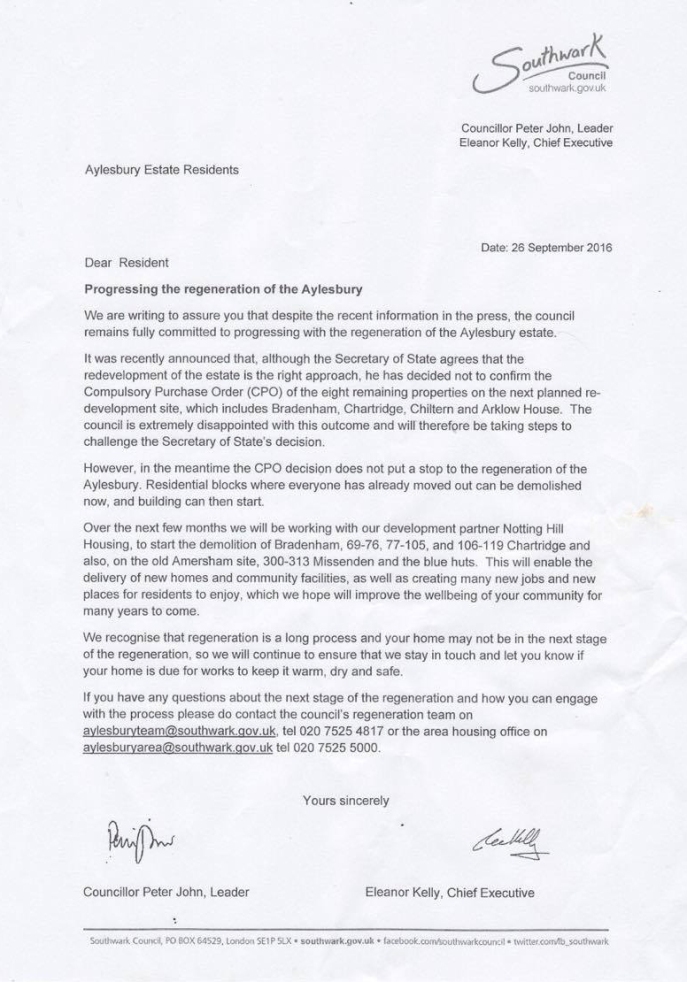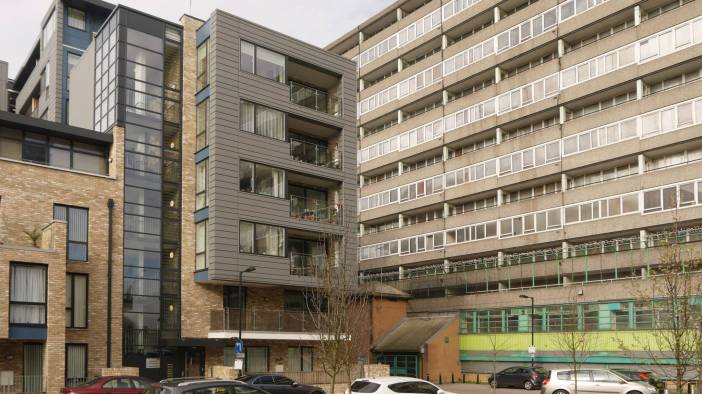Refurbishment versus Demolition and Rebuild
As an independent academic witness at the Public Inquiry into the Aylesbury Estate Compulsory Purchase Order (held on 28 April-1 May, 12 May, and 13–14 October, 2015), a key aspect of the evidence I gave was based on a study of the documents circulated to the meeting of the Executive Committee of Southwark Council on 27 September 2005, at which the decision to demolish and rebuild rather than to refurbish the Aylesbury Estate was made. I argued that the information provided to the Executive Committee for that meeting was inadequate and unbalanced, and key designed costings had not been included. Some of these documents can be viewed on Southwark Council’s website page.
Extraordinarily, the information for the option to demolish and rebuild the Aylesbury Estate consisted of a one-page ‘Indicative Cashflow Forecast’ (Annex C). For reasons we can only speculate on, access to this particular option is now blocked on the Council’s website, but it can be viewed here. This forecast included figures for ‘estimated land value’, ‘income from development’, ‘leaseholders CPO’ and ‘tenants decant’, but there were no figures given for design or construction. There were also figures for ‘delivery team fees’ and ‘master plan’, but no master plan was attached, nor were there any designs or information on construction. To make matters worse, Annex C contained no code to allow the reader to decipher the abbreviated terms, so it was not possible to understand the costs to which some of the figures referred. I concluded, therefore, that this one-page cash-flow report did not constitute sufficient evidence on which to base a decision to demolish and rebuild the Aylesbury Estate.
Even more astonishingly, the information for the refurbishment option, which stretched to a one-and-a-half page summary document titled ‘Costs of Refurbishment’ (Annex A), estimated the total cost of refurbishment to Decent Homes Plus as £314.6 million. And although Southwark Council had commissioned substantial research, designs and costings for the refurbishment option – specifically, a large design package (up to RIBA Stage E, and in some cases F and G) provided by Levitt Bernstein Architects, an accompanying 71-page report by Frost Associates and a 20-page report by BTPW Partnership – none of this detailed information was provided to the Executive Committee. As can be seen, however, in accounting for this enormous sum, Annex A included a figure of £148.9 million for External Works, nearly half the total estimated cost of refurbishment; yet I have been unable to correlate this figure with the calculations in the Frost and the BPTW reports. The BPTW report gave a total figure for external works for the whole estate as £24.8 million, less than a quarter of the Council’s total; and although the Frost report did not give a total figure, even by adding up all the figures given for the external works for each relevant block on the estate I could only reach a total of £20.7 million. So when faced with such a high figure for the refurbishment costs and no background details to justify it, it is perhaps understandable why the Executive Committee decided to reject the option to refurbish the Aylesbury Estate.
The work undertaken by Levitt Bernstein Architects for the south-west corner of the Aylesbury Estate – which was presented to Southwark Council in November 2004, nearly a year before the meeting of the Executive Meeting on 27 September 2005 – also included the only designed and costed comparison between the refurbishment and demolition-rebuild options that I could find. This comparison, which consisted of 3 options for refurbishment and 2 options for demolition-rebuild, showed that – taking as an example a 5-storey block such as 1-68 Chartridge House – the cost of Option 3 for refurbishment to Decent Homes Standard, plus gas removal and structural strengthening, was £3.54 million; whereas the cost of Option 4, for demolishing the block and constructing a new block with the same number of dwellings, was £9.45 million. Even if one estimated the cost of refurbishment at Decent Homes Plus (that is, including new kitchens and bathrooms), then refurbishment remained at 58 per cent of the demolition-rebuild cost, or 41 per cent in the case of those blocks which did not require removal of gas and structural strengthening. For the record, these were the 4-storey blocks (of which there were 17), and the blocks of 7-storeys and above (of which there were 8); it was only the 5-storey (of which there were 20) and 6-storey (only 1) blocks that required structural strengthening, as confirmed by the analysis in the Conisbee Report of March 2005.
Finally, a further document not circulated to the Executive Committee was Option 5, for demolishing and rebuilding the blocks with the addition of new dwellings. These designs show that a block could be rebuilt to provide the same number of replacement dwellings (68), plus additional dwellings (40), on the same footprint. If the aim of regeneration is to increase the housing density of the site, then why was this option not explored to see if the receipts from the sale of the new dwellings could cover the costs of refurbishing – rather than demolishing – the existing homes?
Fast forward a decade, and the Government Inspector’s CPO Report to the Secretary of State for Communities and Local Government, published on 29 January 2016, stated that: ‘The figures put to the Executive Committee are more than 10 years old, and there is no submitted evidence which would allow me to compare them with the costs of the scheme for the Order Land.’ She adds that a refurbishment scheme ‘would be unlikely to deliver a comparable increase in the number of dwellings’.
The Inspector is quite right to say that there is no submitted evidence on which to make a comparison, because a costed scheme for demolition and rebuild on the Order Land did not exist at the time the decision to demolish the Aylesbury Estate was taken on 27 September 2005. And in fact, it is still not possible to make such a comparison today, or to claim that the new scheme is viable, because key aspects of the financial arrangements between Notting Hill Housing Trust and Southwark Labour Council have been redacted and are not available for public scrutiny.
What we do know, however, from the only designed and costed comparison between demolition-rebuild and refurbishment that exists – which is to say, the one commissioned by Southwark Council and provided by Levitt Bernstein in 2004–05 in their scheme for the south-west corner of the Aylesbury Estate – is that:
- Refurbishment of the estate was the cheaper option;
- New dwellings could have been added while retaining the existing footprint of the estate.
However, not only was this information not put before the Executive Committee in 2005, but it appears not to have been taken seriously by the Public Inquiry into the Aylesbury Estate CPO in 2015.
Architects and Estate Regeneration
So what does all this mean for the architectural community – in professional practice and academia?
- First, I would like to see architects involved in estate regeneration taking into account the effects of demolition on the lives of estate residents – tenants and leaseholders alike – and availing themselves of current research showing the numbers of residents who have had to leave their neighbourhoods and London as a result of the demolition of their homes.
- Second, I would advise architects not to take at face value the claims of councils regarding the provisions they have made for leaseholders to remain through provision of ‘like for like’ (or now ‘equivalent’) accommodation, or tenants’ ‘right to return’, but to look at the evidence, as Professor Loretta Lees has done in her report on the Aylesbury Estate.
- Third, for economic, social and environmental reasons – and in some cases for reasons concerning architectural heritage – it would be great if architects used their design expertise to explore options that prioritise refurbishment. There are many excellent refurbishment examples, nationally and internationally, that can be drawn on. And if the data is being withheld, then we need to collaborate to obtain the relevant information.
The case of Islington’s Six Acres Estate, for example, which consisted of the refurbishment of an estate built using the same construction system and at roughly the same time as the Aylesbury Estate, could have provided the Public Inquiry with an excellent comparison. Instead the Inspector described the information on the scheme that we provided to the Inquiry as ‘limited and largely anecdotal’. The difficulty for us was that Islington Council declined an invitation to provide detailed evidence – which I can only imagine was for political reasons, since Islington, like Southwark, is a Labour council.
In the case of the Aylesbury Estate, I have enormous respect for the work that Levitt Bernstein Architects did, and I believe that Southwark Council should have shared the detail of that work with the Executive Committee when making the decision on the future of the estate. Instead, despite the fact that the Second Stage Tender documents were due to go out on 31 May 2005, the Levitt Bernstein Executive Summary of their work states that ‘On 1 April 2005 the Client gave notice to Levitt Bernstein to stop work pending resolution of structural strengthening and other funding matters and to provide a RIBA Stage E Report on work to date.’ In actual fact, however, resolution of the structural strengthening issues had already been provided in the second Conisbee Report, dated 10 March 2005, which noted that structural strengthening was not required for the 4-storey blocks (of which there were 17) or the 7-, 8- and 14-storey blocks (of which there were 8), only for the 5-storey blocks (of which there were 20) and single 6-storey block.
Levitt Bernstein subsequently declined an invitation to give evidence at the Public Inquiry into the Aylesbury Estate CPO – I assume because of their professional relationship with Southwark Council. Following their design and costing comparison for the south-west corner of the Aylesbury Estate, the Council employed them for its demolition and redevelopment, a project that was completed in 2012, three years before the Inquiry.
It is understandable that architects need to make a living, so perhaps this is where academics can come in to help with this research. I’d like to see us working together more to access key information to inform decisions around estate regeneration that are more just. Because of the invaluable design service that architects provide for their clients – councils, housing associations and property developers – they are in a strong position to help these clients choose options for housing that benefit existing residents. It’s not too late to return and re-examine the proposals drawn up by Levitt Bernstein Architects, which provide options that, unlike Southwark Council’s current plans, would not result in residents of the Aylesbury Estate losing their homes.
Professor Jane Rendell
Director of Architectural Research at the Bartlett School of Architecture
University College London

